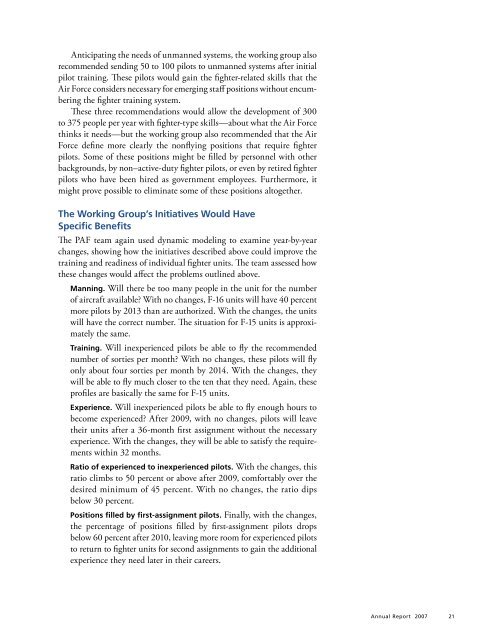RAND Project AIR FORCE Annual Report 2007 - RAND Corporation
RAND Project AIR FORCE Annual Report 2007 - RAND Corporation
RAND Project AIR FORCE Annual Report 2007 - RAND Corporation
You also want an ePaper? Increase the reach of your titles
YUMPU automatically turns print PDFs into web optimized ePapers that Google loves.
Anticipating the needs of unmanned systems, the working group alsorecommended sending 50 to 100 pilots to unmanned systems after initialpilot training. These pilots would gain the fighter-related skills that theAir Force considers necessary for emerging staff positions without encumberingthe fighter training system.These three recommendations would allow the development of 300to 375 people per year with fighter-type skills—about what the Air Forcethinks it needs—but the working group also recommended that the AirForce define more clearly the nonflying positions that require fighterpilots. Some of these positions might be filled by personnel with otherbackgrounds, by non–active-duty fighter pilots, or even by retired fighterpilots who have been hired as government employees. Furthermore, itmight prove possible to eliminate some of these positions altogether.The Working Group’s Initiatives Would HaveSpecific BenefitsThe PAF team again used dynamic modeling to examine year-by-yearchanges, showing how the initiatives described above could improve thetraining and readiness of individual fighter units. The team assessed howthese changes would affect the problems outlined above.Manning. Will there be too many people in the unit for the numberof aircraft available? With no changes, F-16 units will have 40 percentmore pilots by 2013 than are authorized. With the changes, the unitswill have the correct number. The situation for F-15 units is approximatelythe same.Training. Will inexperienced pilots be able to fly the recommendednumber of sorties per month? With no changes, these pilots will flyonly about four sorties per month by 2014. With the changes, theywill be able to fly much closer to the ten that they need. Again, theseprofiles are basically the same for F-15 units.Experience. Will inexperienced pilots be able to fly enough hours tobecome experienced? After 2009, with no changes, pilots will leavetheir units after a 36-month first assignment without the necessaryexperience. With the changes, they will be able to satisfy the requirementswithin 32 months.Ratio of experienced to inexperienced pilots. With the changes, thisratio climbs to 50 percent or above after 2009, comfortably over thedesired minimum of 45 percent. With no changes, the ratio dipsbelow 30 percent.Positions filled by first-assignment pilots. Finally, with the changes,the percentage of positions filled by first-assignment pilots dropsbelow 60 percent after 2010, leaving more room for experienced pilotsto return to fighter units for second assignments to gain the additionalexperience they need later in their careers.<strong>Annual</strong> <strong>Report</strong> <strong>2007</strong> 21
















